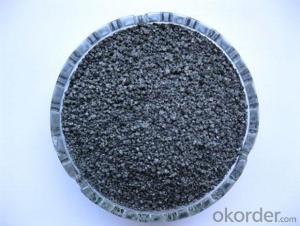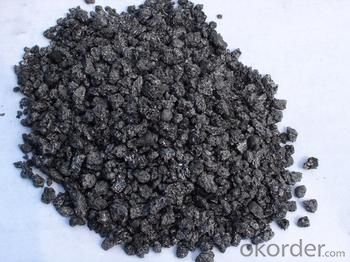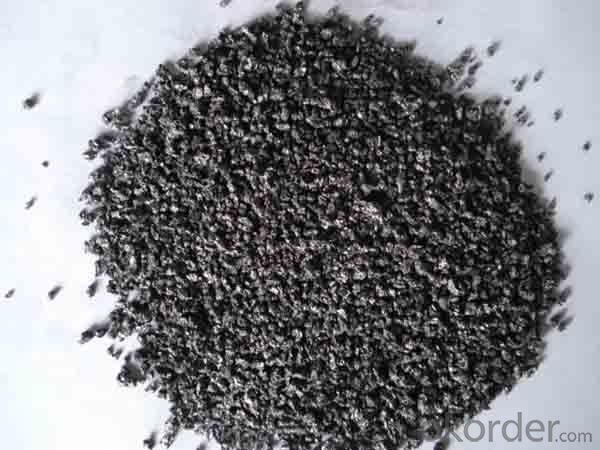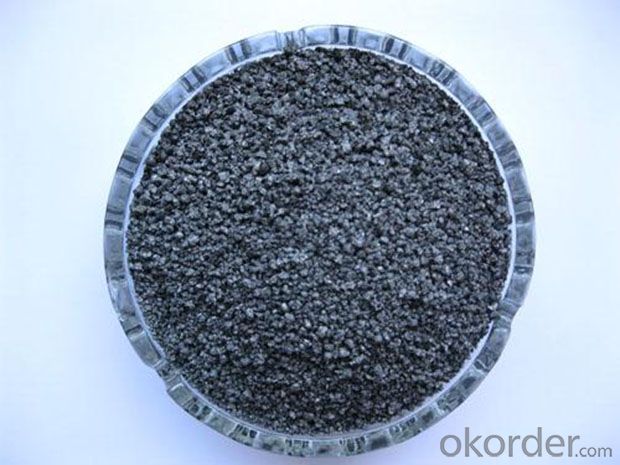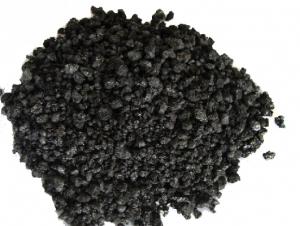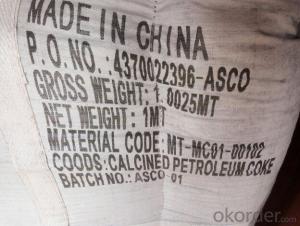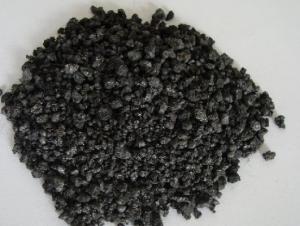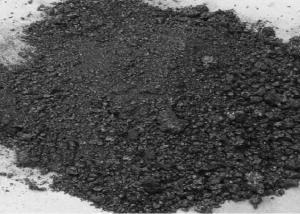FC 98.5 S 0.3 Calcined Petroleum Coke/CPC
- Loading Port:
- Tianjin
- Payment Terms:
- TT OR LC
- Min Order Qty:
- 1 m.t.
- Supply Capability:
- 10000000 m.t./month
OKorder Service Pledge
OKorder Financial Service
You Might Also Like
1.Structure of Calcined Petroleum Coke Description
Calcined Petroleum Coke is made from raw petroleum coke,which is calcined in furnace at a high temperature(1200-1300℃).CPC/Calcined Petroleum Coke is widely used in steelmaking,castings manufacture and other metallurgical industry as a kind of recarburizer because of its high fixed carbon content,low sulfur content and high absorb rate.Besides,it is also a best kind of raw materials for producing artifical graphite(GPC/Graphitized Petroleum Coke) under the graphitizing temperature(2800℃).
2.Main Features of the Calcined Petroleum Coke
High-purity graphitized petroleum coke is made from high quality petroleum coke under a temperature of 2,500-3,500°C. As a high-purity carbon material, it has characteristics of high fixed carbon content, low sulfur, low ash, low porosity etc.It can be used as carbon raiser (Recarburizer) to produce high quality steel,cast iron and alloy.It can also be used in plastic and rubber as an additive.
3. Calcined Petroleum Coke Images
4. Calcined Petroleum Coke Specification
| Place of Origin: | Shanghai, China (Mainland) | Type: | Carbon Additive | Fixed Carbon (%): | 98.5% |
| Brand Name: | CNBM | Model Number: | CNBM | over 2.0: | Real density |
| Working Temperature: | 1300~1400℃ | Dimensions: | 5-10mm | H Content (%): | ≤0.01% |
| Volatile: | ≤0.5% | Ash Content (%): | ≤1% | S Content (%): | ≤0.3% |
| N Content (%): | ≤0.8% | Shape: | carbon particle | Application: | Additives of Metallurgy |
5.FAQ of Calcined Petroleum Coke
1). Q: Are you a factory or trading company?
A: We are a factory.
2). Q: Where is your factory located? How can I visit there?
A: Our factory is located in ShanXi, HeNan, China. You are warmly welcomed to visit us!
3). Q: How can I get some samples?
A: Please connect me for samples
4). Q: Can the price be cheaper?
A: Of course, you will be offered a good discount for big amount.
- Q: What are the health effects of carbon pollution?
- The health effects of carbon pollution include an increased risk of respiratory problems such as asthma and chronic obstructive pulmonary disease (COPD), cardiovascular diseases, and even premature death. Carbon pollution can also worsen existing health conditions, particularly in vulnerable populations such as children, the elderly, and those with pre-existing respiratory or cardiovascular conditions. Additionally, carbon pollution contributes to climate change, leading to more frequent and intense heatwaves, extreme weather events, and the spread of infectious diseases, further impacting human health.
- Q: How does carbon contribute to the hardness of steel?
- The hardness of steel is enhanced by carbon through a process called carbonization. By introducing carbon atoms into the iron lattice of steel, interstitial solid solutions are formed, resulting in distortion of the lattice. This distortion hinders the easy sliding of iron atoms, thereby increasing resistance to deformation and enhancing the hardness of the steel. The strength and hardness of steel are further enhanced by increasing the carbon content, but only up to a certain limit. Nonetheless, excessive carbon can render the steel brittle, thus it is crucial to strike a balance to attain optimal hardness without compromising other properties of the steel.
- Q: What are the impacts of carbon emissions on the stability of savannas?
- The impacts of carbon emissions on the stability of savannas are significant. Increased carbon emissions contribute to the greenhouse effect, leading to global warming and climate change. These changes in climate can directly affect the natural balance and stability of savannas. One of the main impacts is an alteration in rainfall patterns. Climate change can disrupt the regular rainfall cycles in savannas, leading to extended periods of drought or intense rainfall events. This can disrupt the ecosystem's natural fire regime, which is crucial for maintaining the savanna's biodiversity and preventing the encroachment of woody vegetation. Additionally, elevated carbon dioxide levels can promote the growth of certain plant species, particularly those that are more efficient at utilizing carbon dioxide. This can lead to changes in the composition and structure of savanna vegetation, favoring the growth of more dominant and invasive species. Such changes can potentially reduce the diversity and resilience of the savanna ecosystem. Furthermore, increased carbon emissions contribute to the acidification of rainwater and soils. This can negatively impact the nutrient availability and composition of savanna soils, affecting the productivity and health of the entire ecosystem. Overall, carbon emissions pose a significant threat to the stability and functioning of savannas, impacting their biodiversity, fire regime, rainfall patterns, and soil health. It is crucial to address and reduce carbon emissions to mitigate these impacts and ensure the long-term conservation of savanna ecosystems.
- Q: How is carbon used in the production of diamonds?
- The production of diamonds relies heavily on carbon, which is the primary component that constructs the diamond's structure. Deep within the Earth's mantle, where there are extreme levels of heat and pressure, carbon atoms bond together in a distinctive crystal lattice formation, giving birth to diamonds. This natural process, called carbon crystallization, takes place over an extensive period of millions of years. To create synthetic diamonds, scientists recreate these intense conditions in a laboratory. They employ high-pressure, high-temperature (HPHT) machines to subject a tiny piece of carbon, like graphite, to immense pressure and heat. This simulation imitates the natural process that occurs in the Earth's mantle, allowing the carbon atoms to rearrange themselves and transform into diamonds. An alternative method, known as chemical vapor deposition (CVD), involves the controlled use of a hydrocarbon gas, such as methane, in a specific environment. The gas is introduced into a chamber and heated, causing the carbon atoms to separate from the hydrogen atoms. These carbon atoms then settle on a substrate, like a diamond seed, and gradually accumulate layer by layer, eventually forming a diamond. In both methods, carbon acts as the fundamental building block for the diamond's structure. By manipulating the conditions in which carbon atoms are exposed to extreme heat and pressure, scientists and manufacturers are able to control the growth and formation of diamonds. This manipulation allows for the production of synthetic diamonds that possess identical physical and chemical properties to natural diamonds. In conclusion, carbon plays an indispensable role in the production of diamonds, serving as the essential element that facilitates the formation and growth of these valuable gemstones.
- Q: Are carbon cells the same as alkaline batteries?
- Carbon battery is not only suitable for the flashlight, radios, tape recorders, cameras, semiconductor, electronic clocks, toys and other fields, but also for national defense, scientific research, telecommunication, navigation, aviation, medicine, etc. in the national economy. Carbon battery is mainly used for low power electrical appliances, such as watches, wireless mouse such as electrical appliances should use alkaline batteries, such as the camera, the camera also hold some basic, it needs to use nimh.Alkaline batteries, also known as alkaline dry cells, alkaline manganese dioxide batteries and alkaline manganese batteries, are among the best in the range of zinc manganese batteries. The utility model is suitable for large discharge capacity and long time use.
- Q: Joint carbide gas incident
- After a lapse of 25 years, a India District Court on 1984 Bhopal gas leak to be long in coming judgment, Union Carbide (India) Co., Ltd. 7 India nationals day was held for negligence causing death, they will face up to two years in prison. On the same day, hundreds of survivors, family members and environmentalists gathered around the courthouse to protest the court's decision that the perpetrators of the worst industrial disaster in twentieth Century were too light and too late. In 1969, Union Carbine Co established a Union Carbide in central India state of Bhopal Beijiao city (India) Co. Ltd., specializing in the production of aldicarb, carbaryl pesticide drops. The chemicals used in these products is called a methyl isocyanate poisonous gas. The early morning of December 3, 1984, this factory storage explosive liquid methyl isocyanate the steel tank, 45 tons of poison gas leak quickly, directly killed more than 1.5 people, allegedly have caused more than 550 thousand people died and chemical poisoning related lung cancer, renal failure and liver disease.
- Q: Emerald garden high carbon tempered metal
- The middle gate's most advanced war puppet! 3 o'clock, 9 o'clock position.Black dealers are also available
- Q: What are the meanings of carbon, graphite, burr, two cuts and four cuts in steel?.
- Flash is to flash, or two bending. Two cuts; one cut two on average, three segments, four cuts; an average cut of four, and five segments. The back is industry talk.
- Q: How is carbon used in water filtration systems?
- Due to its impressive adsorption properties, carbon is widely used in water filtration systems. Adsorption occurs when the molecules of a substance bind to the surface of another material, which is the case with carbon in this context. In water filtration, activated carbon is particularly effective. It is carbon that has undergone special processing to create a large surface area. When water passes through the filtration system, the carbon captures and retains various impurities, including organic compounds, chlorine, volatile organic compounds (VOCs), and certain heavy metals. This adsorption process effectively eliminates unpleasant odors and tastes, making the water more enjoyable to drink. Furthermore, carbon plays a crucial role in removing potentially harmful contaminants such as pesticides, herbicides, and pharmaceutical residues. Additionally, carbon filtration systems aid in reducing the risk of waterborne illnesses by eliminating bacteria, viruses, and parasites. In summary, carbon is an indispensable element of water filtration systems as it greatly enhances the quality and safety of drinking water.
- Q: What are the different types of carbon-based air pollutants?
- There are several different types of carbon-based air pollutants that contribute to air pollution. These include: 1. Carbon Monoxide (CO): This is a colorless, odorless gas produced by the incomplete combustion of fossil fuels, such as gasoline, coal, and wood. It is highly toxic and can be harmful to human health, particularly when inhaled in high concentrations. 2. Carbon Dioxide (CO2): This is a greenhouse gas that is naturally present in the Earth's atmosphere. However, human activities such as the burning of fossil fuels and deforestation have significantly increased its levels, leading to climate change and global warming. 3. Volatile Organic Compounds (VOCs): These are organic chemicals that easily vaporize at room temperature. They are released into the air by various sources, including paints, solvents, gasoline, and industrial processes. VOCs contribute to the formation of ground-level ozone, which is a major component of smog and can be harmful to human health. 4. Methane (CH4): This is another greenhouse gas that is primarily produced by the decomposition of organic materials in landfills, as well as the extraction and transportation of natural gas. Methane is a potent greenhouse gas, with a much higher warming potential than carbon dioxide. 5. Polycyclic Aromatic Hydrocarbons (PAHs): These are a group of chemicals that are formed during the incomplete combustion of organic materials, such as coal, oil, and gas. PAHs are released into the air through vehicle exhaust, industrial processes, and the burning of fossil fuels. They are known to be carcinogenic and can have harmful effects on human health. 6. Formaldehyde (HCHO): This is a colorless gas that is used in the production of resins and plastics, as well as in some building materials and household products. It is released into the air through the burning of fuels, cigarette smoke, and the off-gassing of certain products. Formaldehyde is a known respiratory irritant and can cause allergic reactions and other health issues. These are just some of the carbon-based air pollutants that contribute to air pollution. It is important to reduce emissions of these pollutants through the use of cleaner technologies, energy-efficient practices, and the promotion of renewable energy sources to mitigate their negative impacts on both human health and the environment.
Send your message to us
FC 98.5 S 0.3 Calcined Petroleum Coke/CPC
- Loading Port:
- Tianjin
- Payment Terms:
- TT OR LC
- Min Order Qty:
- 1 m.t.
- Supply Capability:
- 10000000 m.t./month
OKorder Service Pledge
OKorder Financial Service
Similar products
Hot products
Hot Searches
Related keywords


